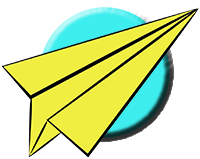How to Fold a Sloop Paper Airplane
How to Fold a Sloop Paper Airplane
Instructions
1. Fold the paper exactly in half about its short edge.
2. Rotate the paper around keeping the previously created fold on the right. The paper should open up from the left hand side.
3. Fold the paper exactly in half about its short edge. Unfold after the crease has been made.
4. Rotate the paper around so the remaining fold is on the left. The paper should open up form the right hand side.
5. Fold the top edge of the paper down so the top edge lines up with the existing center line crease. Unfold after the crease has been made.
6. Fold the upper left corner down. The right point of the new crease should be at the upper right corner of the paper and the left point should be at the left edge of the top horizontal crease.
7. Unfold the crease just made.
8. Rotate the paper around so the previously created creases are at the bottom.
9. Fold the top edge of the paper down so the top edge lines up with the existing center line crease. Unfold after the crease has been made.
10. Fold the upper right corner down. The left point of the new crease should be at the upper left corner of the paper and the right point should be at the right edge of the top horizontal crease.
11. Unfold the crease just made.
12. Unfold the paper so it is completely open and flat on the working surface.
13. Pop the left and right points of the horizontal crease up bringing them in towards the middle about the existing diagonal creases. Bring the top edge over and down so it lines up with the bottom edge.
14. Rotate the paper around so the nose is at the bottom.
15. Fold the top edge of the paper down. The new crease should line up with the inner points of the triangular layers underneath the top-most layer and be parallel with the bottom edge of the paper. Notice how the new crease goes through the inner-most points of the triangular sections.
16. Make a crease to fold over the right center point. The left point of the new crease should be where the lower right triangular section hits the horizontal crease and the right point should be about two finger widths up from the lower right corner.
17. Make a crease to fold over the left center point. The right point of the new crease should be where the lower left triangular section hits the horizontal crease and the left point should be about two finger widths up from the lower left corner.
18. Fold the upper right corner over so the upper right point hits the center line crease. When folded correctly, the right half of the top edge should line up with the center line crease.
19. Fold the upper left corner over so the upper left point hits the center line crease. When folded correctly, the left half of the top edge should line up with the center line crease.
20. Fold the tip of the nose down so the top point hits the center line crease. When folded correctly, the top point should hit the center line crease at the narrowest point along the body of the plane.
21. Flip the plane over and rotate it around so the previously created folds are underneath and the nose points to the left.
22. Fold the plane exactly in half about the existing center line crease. Be sure to line up the sides for good balance.
23. Rotate the plane around so the wing flaps are up and the nose points to the right.
24. Make a crease for the first wing flap. The right point of the new crease should be about one finger width up from the edge of the fuselage and the left point should be about two finger widths up from the bottom edge.
25. Flip the plane over and rotate it around so the first wing flap is underneath and the nose points to the left.
26. Make a crease for the second wing flap. Be sure to line up the wing flaps for good balance and flying characteristics.
27. Unfold the wing flaps and adjust the wing angles so they are even. Set the dihedral angle flat to slightly upward.
THE THROW Launch with a moderate to hard throw at a slight up angle. The sloop is a sturdy flyer and can be trimmed and experimented with in a variety of ways. Basically a glider which tends to float and stall. The wing area can be reduced by making various flaps out of the front or back wing sections for flying variety.
